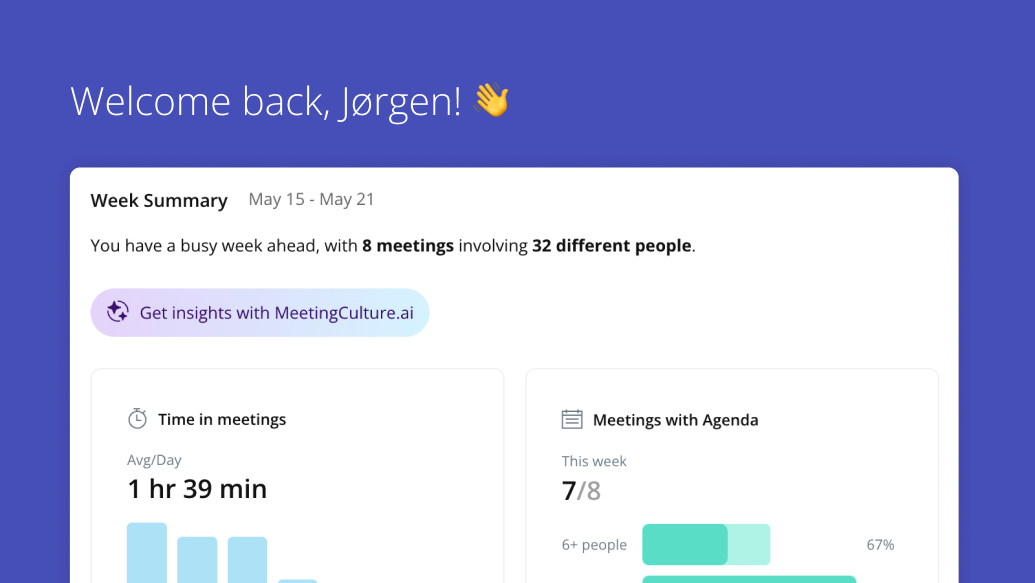Hybrid is Here to Stay: Designing Meetings for the Modern Workforce
To maximize the effectiveness of hybrid meetings, it takes the right tools and thoughtfulness from leadership.
The New Norm: Hybrid Meetings
In today's rapidly evolving work environment, the concept of remote work has become increasingly prominent, and the COVID-19 pandemic further accelerated its widespread adoption in many industries.
As a result, hybrid meetings — those that cater to both in-person and remote participants — have become the new norm.
By embracing the hybrid model, organizations can ensure seamless collaboration, enhanced productivity, and meaningful engagement for all participants.
The Rise of Hybrid Meetings
Over the past few years, the traditional notion of what a meeting is has undergone a significant transformation. Hybrid meetings have emerged as the go-to format for organizations seeking to adapt to the changing work landscape and to increase employee productivity, retention and morale.
The rise of remote work and the proliferation of digital communication tools have made it possible for teams to connect and collaborate across geographical boundaries with ease. With hybrid meetings, companies can tap into a larger talent pool, foster diverse perspectives, and provide flexibility to their employees — all while increasing output and organizational effectiveness.
The Benefits of Hybrid Meetings
Designing meetings for the modern workforce involves understanding the advantages of the hybrid approach. One of the key benefits is increased inclusivity. By incorporating remote participants, hybrid meetings ensure that everyone has an equal opportunity to contribute, regardless of their physical location. This inclusivity fosters diversity, enables a wider range of viewpoints, and promotes a sense of belonging within the organization.
Another perk is improved productivity. Hybrid meetings eliminate the need for excessive travel and offer flexibility to participants, leading to time savings and increased efficiency. Moreover, hybrid meetings enable organizations to reduce their carbon footprint by minimizing commute- and travel-related emissions, aligning with sustainability goals.
Strategies for Effective Hybrid Meetings
To design effective meetings for the modern workforce, consider the following strategies:
- Embrace technology: Leverage reliable meeting management apps that offer features specifically designed for hybrid meetings. These tools provide seamless integration between in-person and remote participants, enabling smooth communication, document sharing, and real-time collaboration.
- Establish clear communication channels: Ensure that all participants, whether in-person or remote, have access to the same information. Establish guidelines for communication, such as using video conferencing tools, chat platforms, or project management software to maintain an open line of communication throughout the meeting.
- Create an inclusive environment: Encourage active participation from both in-person and remote attendees. Facilitate equal opportunities for everyone to contribute ideas, ask questions, and share feedback. Consider assigning a moderator or meeting facilitator to manage the flow of the meeting and ensure that all voices are heard.
- Set meeting norms and expectations: Establish guidelines for meeting etiquette, such as muting microphones when not speaking, being all on camera or all off camera whenever possible, and respecting others' time. Clearly communicate the meeting's objectives, agenda, and expected outcomes well in advance to keep participants focused and engaged.
- Foster engagement through interactive activities: Incorporate interactive elements into your meetings, such as polls, surveys, or breakout sessions. These activities encourage active participation and help build connections among team members, regardless of their physical location.
As hybrid work environments become the new normal, designing meetings that cater to the modern workforce is crucial for organizations to thrive. By embracing the hybrid model, businesses can leverage the benefits of inclusivity, increased productivity, and environmental sustainability.
Implementing effective strategies, such as embracing technology, establishing clear communication channels, creating an inclusive environment, setting meeting norms, and fostering engagement, will help organizations unlock the full potential of their hybrid meetings.
With thoughtful planning and the right tools, organizations can make hybrid meetings a major component of their organizational success.
Meeting Management Solutions for the Modern Hybrid Workforce
To truly create the perfect hybrid meeting, it will take the right tools and thoughtfulness from leadership. Fortunately, some solutions can optimize your hybrid meetings every time.
Decisions meeting management app allows users in the hybrid workforce to connect meaningfully before, during, and after meetings. With a suite of productivity tools such as collaborative agendas, the ability to assign presenters to agenda items, a time tracker, and an in-Teams side-panel view of the meeting, hybrid meetings are no longer an unsolvable problem.

